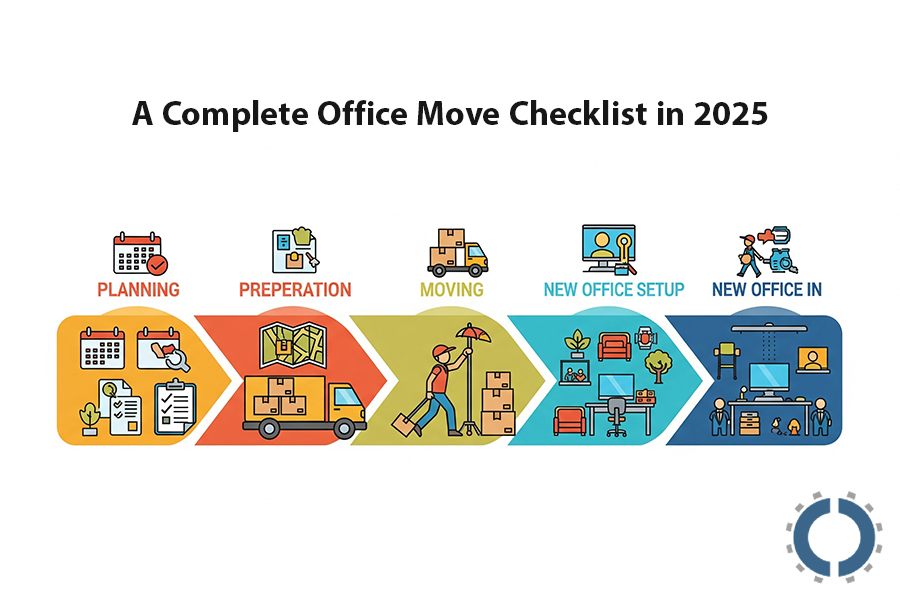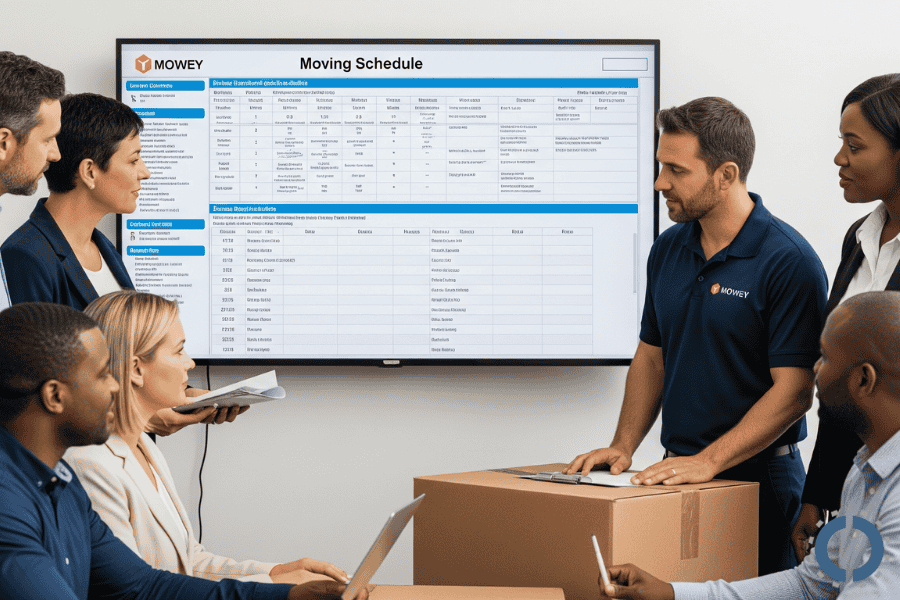A Complete Office Move Checklist in 2025

Relocating an office, whether due to business expansion or a change in needs, can seem like a complicated and challenging process for business owners.
In today’s world, where speed and efficiency are paramount, any disruption in an organization’s workflow can result in heavy costs.
For this reason, having a complete office moving checklist is not only a suggestion, but a necessity.
This will be a multi-step process requiring meticulous planning and multi-step preparation.
This comprehensive checklist in 2025 will help you manage the moving process from start to finish with careful, step-by-step planning.
By using this guide, you can effectively minimize downtime, reduce stress from the unknown, and ensure that no important details are missed along the way.
This article will help you move into your new workspace with a clear and organized vision and have a successful office relocation experience.
As with any complicated process, an office move will benefit from organized planning, which breaks the process down into manageable components.

1. Early Planning: 6-12 Months Before the Move
Lease Management
During this time frame, the most important action is to manage the current office lease agreement.
First, you should carefully review the terms of the current contract.
It is very important to pay attention to the clauses regarding notice period to the landlord because most contracts require formal notice of vacating the property several months in advance.
You should also check the Restoration Clauses.
Many landlords expect the tenant to restore any changes, such as installing demountable walls and partitions, changing flooring, or painting, to their original condition before handing over the space.
These measures may require significant time and expense, which must be factored into planning.
Financial Planning

In the initial planning stage of relocation, one of the most essential steps is detailed financial planning.
At this stage, a comprehensive and realistic budget should be developed for all aspects of the office move.
This budget should cover all significant and incidental expenses.
In the first step, the cost of the moving company’s services should be estimated; these services may include packing, transporting, unloading, insuring the items, and even reassembling them at the new location.
In the next step, the cost of purchasing or replacing new modern office furniture and equipment should be considered if needed.
Also, a significant portion of the budget should be allocated to IT infrastructure, including network installation, servers, internet, telephones, computer equipment, and the necessary cabling.
Be sure to also set aside some budget for unforeseen expenses, so you are not surprised.
New Location Selection
In the office move checklist, choosing a new location is one of the most important decisions that has a direct impact on productivity, employee satisfaction, and future business growth.
This decision should be made based on the organization’s real needs, the identified budget, as well as current and future work styles, including hybrid work.
As a first step, you need to choose a new space that is in line with your business activities and priorities in terms of location.
Along with location, the physical dimensions of the space are also important; it must be ensured that the space is large enough to meet current needs and expandable for the future.
The new space should allow for a variety of work environments, including flexible workspaces, meeting rooms, quiet areas for focused work, and collaborative or creative spaces.
Team Formation
In the office relocation process, forming an executive team plays a very important role in the orderly, coordinated, and stress-free implementation of the project.
At this stage, an internal project manager or a committee responsible for the relocation should be designated to prevent potential mistakes.
If you have a larger organization, it would be very helpful to form a committee consisting of representatives from different departments such as IT, finance, HR, and operations.
It is important that this team is active from the beginning to the end of the project and holds regular meetings to review progress so that the needs and concerns of each team are taken into account.
Mover Selection

In the next steps of the office move checklist, one of the important parts is choosing a professional moving company.
Choosing a reliable and experienced company can make a big difference in the moving process and prevent financial losses, delays, or chaos.
First, you need to do thorough research on commercial moving companies.
It is very important to review their background, experience, previous clients, and expertise in office relocation.
Be sure to check user reviews, online ratings, and recommendations from other companies to make sure you’re dealing with a trustworthy company.
Check what services are included in each offer.
For example, some companies only do the moving, while others also offer packing, organizing, and unpacking services.
Initial Documentation
During an office relocation process, preparing initial documentation is an essential step to ensure order, continuity, and transparency throughout all stages.
One of the most important of these documents is to prepare a Master Timeline and a Comprehensive To-Do List for the entire relocation process.
Having this documentation as a roadmap will help you avoid confusion, accurately track project progress, and take quick corrective action if necessary.
2. Intermediate Planning: 3-6 Months Before the Move
Communication Strategy
In the office move checklist, developing an effective communication strategy is very important because this relocation is not just a physical change, but an organizational change that affects employees, customers, business partners, and government entities.
This strategy should be divided into two main parts: internal communications with employees and external communications with clients and stakeholders.
In internal communications, the main goal is to create transparency, reduce anxiety, and engage employees.
In external communications, it is necessary to inform all people who communicate with you outside the company of the change of address.
Sending official announcements, updating the address on the website, email signatures, business cards, invoices, and official documents are among the important actions.
Office Design and Layout

Planning for the layout of a new office should be done in such a way that the right balance is created between focused workspaces, collaborative spaces, meeting rooms, public areas, as well as quiet areas for concentration.
Due to the popularity of hybrid work models, designing meeting rooms to be equipped with video conferencing equipment is doubly important.
Additionally, dedicating spaces for informal interaction between employees can help improve team spirit and creativity.
Another vital point is to comply with accessibility standards in environmental design.
The efficient and principled design of the new space will increase job satisfaction, facilitate interaction between teams, and enhance the company’s professional image.
IT and Technology Infrastructure
During an office relocation, re-establishing the IT infrastructure is one of the most critical and sensitive steps.
For this reason, you should work closely with the organization’s IT department long ago to develop a comprehensive IT and Technology Infrastructure plan.
This plan should cover all technical aspects, including setting up a new network (cable and Wi-Fi), transferring and securing data, cybersecurity infrastructure, telephone systems, and the physical relocation of all technology equipment such as servers, switches, computers, and printers.
Early coordination with Internet Service Providers (ISPs), telephone, and cloud technology should also be prioritized to avoid any disruptions to access or system performance.
Inventory Management and Decluttering
This step helps the organization not only reduce the volume of portable equipment but also optimize resources and save on transportation costs.
As a first step, a comprehensive inventory of all physical office assets, such as office furniture and equipment, should be prepared.
Once the list is made, it’s time to implement a cleanup and update strategy.
This step involves separating unnecessary, worn-out, or outdated items, especially equipment that has not been used for a long time or is no longer compatible with current work needs.
Instead of moving these items to a new space and taking up resources and space, they can be recycled, donated, or disposed of safely.
Many physical documents can also be scanned and digitized, both to reduce paper volume and to more efficiently use physical space in the new office.
Procurement
This stage involves two main aspects: purchasing new furniture and equipment for the new office and preparing packing supplies to carry out a safe and orderly move.
In the first step, you need to consider what items are needed for the new space.
This may include new desks, office chairs, filing cabinets, electronic equipment, lighting, and decor.
Depending on the new layout, modern or mixed work style, some equipment may require special design or a custom order.
For this reason, orders must be placed taking into account the delivery time so that the desired items are delivered on time and do not cause delays in deployment.
Along with purchasing new items, it is also essential to prepare packing and moving supplies.
3. Pre-Move Preparations: 1-2 Months Before the Move
Vendor and Utility Finalization

This step of the office move checklist ensures that the move to the new location takes place without disruption to critical services and that the company’s business processes resume immediately.
In the first step, all arrangements and agreements with the selected transportation company, the owner or manager of the new building, and all essential service providers such as electricity, internet, and telephone must be definitively and officially confirmed.
This includes confirming the exact time of move-in, the conditions for entering the new building, the services that can be provided on move-in day, as well as checking insurance or contractual liabilities.
Next, steps must be taken to launch new services in the new office.
Business Information Updates
After moving your office, one of the essential steps to maintain brand credibility and ensure that your company is found correctly by your audience is to update your business information.
At this stage, all digital and physical platforms that contain the company’s contact information or address should be updated in a planned and coordinated manner.
Data Security
Data security is particularly important during this period, as technology infrastructure and documents may be exposed to physical or digital vulnerabilities during the relocation process.
The first and most important step is to back up all critical company data, which should be done before transferring any technology or network equipment.
In addition to backups, it is best to digitize important physical documents to allow for faster access and better control over data.
Packing Strategy
At this stage, a systematic system should be designed for packaging and labeling all items, boxes, and furniture.
This system should be such that each item can be easily identified, tracked, and placed in its proper place in the new office.
Clear labeling on each box is vital.
The labels should include information such as the contents of the box, the name of the relevant department or employee, and its destination in the new space.
Also, fragile or sensitive items such as IT equipment, monitors, or technical tools should be packed with protective materials such as bubble wrap or foam and marked to ensure they are handled with more care during transport.
Logistics and Cleaning
One of the important steps in the office relocation checklist is to plan to use professional cleaning services at both the current and the new office locations.
On the other hand, the distribution of new keys or access cards to employees should also be done before the official transfer.
Employee Engagement
Changing the work environment can be stressful for some employees.
Therefore, creating a sense of positivity and engagement among employees can reduce concerns and increase collaboration.
To create motivation and excitement about the move, it is best to establish clear, two-way communication with employees via email or short meetings from the beginning of the process.
Employees can also be invited to provide feedback on the design of the new space, the equipment needed, or even the naming of rooms and workspaces to foster a sense of ownership and participation.
4. The Final Countdown: 1-2 Weeks Before the Move
Confirmation and Coordination

At this stage, all details of the office move checklist should be carefully reviewed and reconfirmed.
First of all, it is necessary to contact the selected transportation company and review the schedule, number of personnel, required equipment, and service conditions once again to ensure their full readiness.
Employee Preparation
One of the important points in the office move process is employee preparation for moving to the new location.
It is best to encourage employees to pack their personal belongings in designated boxes or bags and, if necessary, place sensitive documents in secure folders.
Creating this culture of responsibility among employees makes the relocation process faster, more orderly, and hassle-free, and everyone experiences a successful transition together.
IT Readiness
At this point, the IT team should prepare a detailed and complete final plan for disconnecting equipment in the old office and restarting it in the new location.
After the equipment is moved, the IT team is responsible for deploying and restarting the network, internet, phone systems, and other infrastructure in the new office so that employees can resume their activities without delay.
Final Checks
One of the important and final steps before leaving the old office is to conduct final inspections to make sure that no equipment or documents are left behind and that everything is ready for handover.
These visits will help you identify any forgotten objects, equipment, or documents and prevent future problems.
5. Moving Day
Supervision
One of the critical steps in the office move checklist on moving day is designating responsible individuals to oversee the loading process at the old office and the unloading process at the new office.
These supervisors’ responsibilities include checking that each box and item is properly packaged and labeled, ensuring that safety precautions are followed during transportation, and overseeing the order in which trucks are loaded.
Also, at the new location, supervisors must ensure that items are properly unloaded and delivered to the appropriate departments to make the setup process faster and more accurate.
IT Setup and Lost and Found
In the early days after moving to a new office, two very important actions need to be taken simultaneously: quickly setting up the IT infrastructure and creating an effective system for finding lost items.
First, immediate IT setup is a priority so that teams can begin their daily activities without delay.
They need to be on site on the very first day to fix any problems immediately and ensure that everything is working properly and safely.
Also, creating a special lost and found area in the new office will help employees easily track and retrieve left-behind or found items.
Old Office Finalization

In the final stage of the office move checklist, special attention should be paid to the final settlement with the previous office.
One of the essential steps at this stage is to conduct a complete final inspection of the evacuated premises to ensure cleanliness, complete evacuation of belongings, and proper condition of the office.
This visit is an opportunity to carefully inspect the condition of the floors, walls, lighting equipment, and other parts, especially if the lease agreement includes specific conditions for returning the office to its original condition.
Support and Morale
During the relocation day and the initial days after deployment, providing a positive and humane environment for the team can have a great impact on reducing stress and increasing satisfaction.
Also, at this stage, patience and flexibility should be observed as one of the key principles by managers.
The complete launch of a new office may be accompanied by challenges or delays, so a calm and supportive approach will help both effectively resolve issues and maintain team morale.
6. Post-Move Activities: Immediately After and Ongoing
Unpacking and Setup
After entering a new office, one of the most important steps is unpacking all boxes, office furniture, equipment, and IT, and arranging them, which must be done quickly, neatly, and following the predetermined design.
System Testing
At this stage, all IT infrastructure, technical equipment, and security systems must be thoroughly and accurately tested to ensure their proper functioning.
Training
If the moving process involves the use of new technologies or systems, such as project management software, VoIP phones, or new multifunction devices, it is important to familiarize users with how to use them correctly to avoid confusion, errors, or reduced productivity.
Official Updates
After moving, it is necessary to update all official company information and the new address with relevant institutions to avoid legal, financial, or administrative problems.
Feedback and Celebration
At this stage of the office move checklist, it is necessary to initially gather employee opinions and feedback on the entire relocation process, from planning to settling into the new location.
Feedback helps identify strengths and weaknesses and provides a basis for better performance in future projects.
Conclusion
Office relocation, although a complex and challenging process, can be a great opportunity for organizational growth, modernization, and productivity improvement if carefully planned and implemented.
A successful office relocation can improve the work environment, increase employee satisfaction, enhance brand image, and align work infrastructure with the organization’s new needs.
For this reason, we have provided a comprehensive office move checklist to ensure that no detail—no matter how small—is overlooked during this process.
Using this office move checklist will help you to plan and execute your next move more easily.
Collaborative Office Interiors carries products from some of the most respected office furniture makers, but did you know we also provide expert interior design and space planning for your new space?
We also:
- Deliver
- Office Furniture Installation
- Disassemble and reassemble
- Liquidate your old, unused furniture.
Contact us if you would like to hear more about our products and services or talk about how we can help.

John Ofield is the owner of Collaborative Office Interiors. Houston’s trusted source for modern and commercial office furniture, office cubicles, demountable walls, office desks and tables, and complete workspace solutions. With more than 40 years of experience, he combines deep product knowledge with hands-on space-planning expertise to create ergonomic, productivity-focused work environments for businesses across Southeast Texas.


